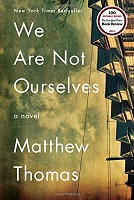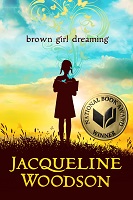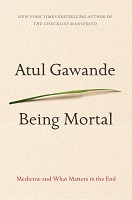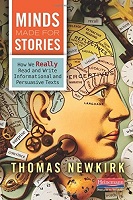What I'm Reading, January 2015
January 03, 2015 at 8:05 PM
Here are the books I’ve read and especially admired in recent months, July 2014–December 2014.
- The Vacationers by Emma Straub, fiction
- New Life, No Instructions: A Memoir by Gail Caldwell
- The Goldfinch by Donna Tartt, fiction
- The Fault in Our Stars by John Green, YA fiction
- Delancey: A Man, A Woman, A Restaurant, A Marriage by Molly Wizenberg, memoir with recipes
- The Swerve: How the World Become Modern by Stephen Greenblatt, nonfiction
- Improbable Scholars: The Rebirth of a Great American School System and a Strategy for America’s Schools by David Kirp, education
- I Know Why The Caged Bird Sings by Maya Angelou, memoir
- Gather Together in My Name by Maya Angelou, memoir
- Singin’ and Swingin’ and Gettin’ Merry Like Christmas by Maya Angelou, memoir
- The Heart of a Woman by Maya Angelou, memoir
- All God’s Children Need Traveling Shoes by Maya Angelou, memoir
- The Absolutely True Diary of a Part-Time Indian by Sherman Alexie, YA fiction
- Clean Gut: The Breakthrough Plan for Eliminating the Root Cause of Disease and Revolutionizing Your Health by Alejandro Junger, M.D. health and well being
- The Principal: Three Keys to Maximizing Impact by Michael Fullan, professional
- Wolf Hall by Hilary Mantel, historical fiction
- Open a World of Possible: Real Stories About the Joy and Power of Reading by Lois Bridges, ed., essays on reading
- Catching Readers Before They Fall: Supporting Readers Who Struggle, K-4 by Pat Johnson and Katie Keier, professional
- The Innovative Society: Five Essential Conditions for Fostering Innovative Activity by Rudolph Kalafus, nonfiction
- Minds Made for Stories: How We Really Read and Write Informational and Persuasive Texts by Thomas Newkirk, professional
- All There Is: Love Stories from Storycorps by Dave Isay, ed., interviews
- Gabriel, A Poem by Edward Hirsch, a prose poem
- Thinking Fast and Slow by Daniel Kahneman, psychology, economics
- Being Mortal: Medicine and What Matters in the End by Atul Gawande, nonfiction, aging
- Brown Girl Dreaming by Jacqueline Woodson, YA memoir in free verse poems
- Lucky Us by Amy Bloom, fiction
- Joyful Literacy Interventions: Early Learning Classroom Essentials by Janet Mort, professional
- The Innovators: How a Group of Hackers, Geniuses, and Geeks Created the Digital Revolution by Walter Isaacson, nonfiction
- We Are Not Ourselves by Matthew Thomas, fiction
- The Woman I Wanted to Be by Diane von Furstenberg, memoir
- Results Coaching: The New Essential For School Leaders by K. Kee, K. Anderson, V. Dearing, E. Harris, and F. Shuster, professional
- Cage-Busting Leadership by Frederick Hess, professional
 I want to elaborate on several books for being especially memorable, thought provoking, and beautifully crafted. For fiction, We Are Not Ourselves by Matthew Thomas (Simon & Schuster, 2014) is a stand-out, knock-out book. I read it twice, the second reading following the first. Thomas’ remarkable first novel of a multi-generational Irish-American family took him ten years to write; he wrote it while working full time as a high school teacher. His book is a gift to the reader for its tenderness, heartbreaking yet uplifting and realistic portrait of a loving but troubled family, and for the main characters who are largely based on his own mother, father, and himself. We come to know these characters intimately and to care so much about them that they—Eileen, Ed, and Connell--stay with us long after we’ve finished the book. The prose is exquisite; the story is compelling; we are not the same after we’ve read it. For more information on We Are Not Ourselves and on Matthew Thomas, his life, and his writing influences, see the book review in The New York Times, the video interview with bookseller Becky Anderson, and Thomas’s Time magazine article “When Will I Die? How I Decided Whether to Test for Early-Onset Alzheimer’s.”
I want to elaborate on several books for being especially memorable, thought provoking, and beautifully crafted. For fiction, We Are Not Ourselves by Matthew Thomas (Simon & Schuster, 2014) is a stand-out, knock-out book. I read it twice, the second reading following the first. Thomas’ remarkable first novel of a multi-generational Irish-American family took him ten years to write; he wrote it while working full time as a high school teacher. His book is a gift to the reader for its tenderness, heartbreaking yet uplifting and realistic portrait of a loving but troubled family, and for the main characters who are largely based on his own mother, father, and himself. We come to know these characters intimately and to care so much about them that they—Eileen, Ed, and Connell--stay with us long after we’ve finished the book. The prose is exquisite; the story is compelling; we are not the same after we’ve read it. For more information on We Are Not Ourselves and on Matthew Thomas, his life, and his writing influences, see the book review in The New York Times, the video interview with bookseller Becky Anderson, and Thomas’s Time magazine article “When Will I Die? How I Decided Whether to Test for Early-Onset Alzheimer’s.”
 I was also especially moved by Jacqueline Woodson’s Brown Girl Dreaming (Penguin Group, 2014), which won the 2014 National Book Award in the young-adult category. It’s a captivating memoir of beautifully written, interconnected poems of Woodson’s life and family—moving from slavery, Jim Crow, the civil rights movement, to Woodson growing up African-American as a child of the ’70s in the U.S. In trying to understand her family history and how her own story fits in the larger context of American history, Woodson notes it is her mission “... to write stories that have been historically absent in this country’s body of literature, to create mirrors for the people who so rarely see themselves inside contemporary fiction, and windows for those who think we are no more than the stereotypes they’re so afraid of.” Brown Girl Dreaming is an excellent model for writing as well as a joy to read. I have read some of these inspiring poems aloud to both young adults and to teachers for both the joy of hearing them and the hope of inspiring them to write a piece of their own memoir in free verse poems.
I was also especially moved by Jacqueline Woodson’s Brown Girl Dreaming (Penguin Group, 2014), which won the 2014 National Book Award in the young-adult category. It’s a captivating memoir of beautifully written, interconnected poems of Woodson’s life and family—moving from slavery, Jim Crow, the civil rights movement, to Woodson growing up African-American as a child of the ’70s in the U.S. In trying to understand her family history and how her own story fits in the larger context of American history, Woodson notes it is her mission “... to write stories that have been historically absent in this country’s body of literature, to create mirrors for the people who so rarely see themselves inside contemporary fiction, and windows for those who think we are no more than the stereotypes they’re so afraid of.” Brown Girl Dreaming is an excellent model for writing as well as a joy to read. I have read some of these inspiring poems aloud to both young adults and to teachers for both the joy of hearing them and the hope of inspiring them to write a piece of their own memoir in free verse poems.
 For nonfiction, I can’t rave enough about Atul Gawande’s Being Mortal: Medicine and What Matters in the End (Henry Holt and Company, 2014), who is a practicing surgeon and a prolific writer. For anyone who is ill, over 60, dealing with aging parents, or wanting to prepare better for end of life issues, Gawande goes into territory that most of us—including doctors—have not fully explored. Being Mortal discusses how to live life fully, including near the end of one’s life, and how to die with maximum comfort, dignity, and peace. Sharing his own humbling professional and personal experiences, Gawande examines the limitations of modern medicine and our societal failures dealing with the elderly and infirm. He takes us deep inside life in hospitals and nursing homes and offers alternative models for long-term care that offer quality of life even near the end of life. He shows us how, as a humane society, we can and must do better. He poses four crucial questions doctors need to ask their patients and that we all need to think about for our own optimal care:
For nonfiction, I can’t rave enough about Atul Gawande’s Being Mortal: Medicine and What Matters in the End (Henry Holt and Company, 2014), who is a practicing surgeon and a prolific writer. For anyone who is ill, over 60, dealing with aging parents, or wanting to prepare better for end of life issues, Gawande goes into territory that most of us—including doctors—have not fully explored. Being Mortal discusses how to live life fully, including near the end of one’s life, and how to die with maximum comfort, dignity, and peace. Sharing his own humbling professional and personal experiences, Gawande examines the limitations of modern medicine and our societal failures dealing with the elderly and infirm. He takes us deep inside life in hospitals and nursing homes and offers alternative models for long-term care that offer quality of life even near the end of life. He shows us how, as a humane society, we can and must do better. He poses four crucial questions doctors need to ask their patients and that we all need to think about for our own optimal care:
- What is your understanding of your health or condition?
- What are your goals if your health worsens?
- What are your fears?
- What are the trade-offs you are willing to make and not willing to make?
I plan to give Being Mortal to my primary care doctor, for whom I have the deepest admiration and respect, with a request that he read the book and stay on as my physician for the rest of my life.
 Finally, one professional book shines through as particularly significant and original in its content: Minds Made for Stories: How We Really Read and Write Informational and Persuasive Texts by Thomas Newkirk (Heinemann, 2014). Newkirk, who teaches at the University of New Hampshire, is a renowned scholar and author of many provocative and groundbreaking books about literacy, learning, and teaching. In Minds Made for Stories, he broadens my own belief that narrative, though narrowly defined in school, needs to be expanded to include informational writing as well. Newkirk persuasively argues, and I applaud him for it, that the best nonfiction writing is also narrative and that the historical modes of writing—description, narration, exposition, and argumentation—cannot and need not be so distinct, which actually makes the teaching process harder. He supports his position with many examples and evidence from his own teaching, work as a writer, experiences as a reader, and work of other writers and researchers. “It also seems to me that if we look—honestly—at how we prefer to learn information, we seek out writers who can embed it in narrative” (p.12, italics are the author’s). “Locate any widely read writer on science or medicine or the environment and you will find someone skilled at narrative writing, one who keeps before our eyes the human consequences of policies and discoveries” (p.19). Certainly, my appreciation and comprehension of Gawande’s Being Mortal is supported by that last quotation. Newkirk also notes that the reading of well-structured nonfiction is not so different than we way we read well-structured fiction. Regardless of the grade level or content you teach, Minds Made for Stories will help make you a better and more thoughtful reader, writer, and teacher—and will also help to put any set of required standards in useful perspective.
Finally, one professional book shines through as particularly significant and original in its content: Minds Made for Stories: How We Really Read and Write Informational and Persuasive Texts by Thomas Newkirk (Heinemann, 2014). Newkirk, who teaches at the University of New Hampshire, is a renowned scholar and author of many provocative and groundbreaking books about literacy, learning, and teaching. In Minds Made for Stories, he broadens my own belief that narrative, though narrowly defined in school, needs to be expanded to include informational writing as well. Newkirk persuasively argues, and I applaud him for it, that the best nonfiction writing is also narrative and that the historical modes of writing—description, narration, exposition, and argumentation—cannot and need not be so distinct, which actually makes the teaching process harder. He supports his position with many examples and evidence from his own teaching, work as a writer, experiences as a reader, and work of other writers and researchers. “It also seems to me that if we look—honestly—at how we prefer to learn information, we seek out writers who can embed it in narrative” (p.12, italics are the author’s). “Locate any widely read writer on science or medicine or the environment and you will find someone skilled at narrative writing, one who keeps before our eyes the human consequences of policies and discoveries” (p.19). Certainly, my appreciation and comprehension of Gawande’s Being Mortal is supported by that last quotation. Newkirk also notes that the reading of well-structured nonfiction is not so different than we way we read well-structured fiction. Regardless of the grade level or content you teach, Minds Made for Stories will help make you a better and more thoughtful reader, writer, and teacher—and will also help to put any set of required standards in useful perspective.
Commentary: Becoming a Reader
My earliest memory of reading was seeing my mother quietly reading, day after day, in the pale light of late afternoon. I envied her that zone of peacefulness and privacy and knew not to disturb that sacred time. She tried to invite me into that world by insisting I read old-fashioned classics such as When Knighthood Was In Flower, first published in 1898. She handpicked similar masterworks at our local public library, and I rebuked and resisted every one of them. I have no childhood memories of learning to read in school, of being read to at home, or of enjoying reading. Other than romantic comic books, which I savored well into my teens, reading was an unpleasant chore, something that had to be done whether one liked it or not.
I was 15 before I formed my first unforgettable reading memory. It stems from an overnight with my grandmother. She read aloud Gone With the Wind by Margaret Mitchell with such emotion that I was spellbound. I finally got it! So this was what reading and hearing great literature could do for the mind and spirit—transport me to another era, enable me to enter the fascinating and complicated lives of different characters, prompt me to rethink my own hopes and desires and become so thoroughly lost in a riveting story that time stopped and nothing else mattered. I was drawn in to savor the sounds and rhythms of well-crafted language—and I was hooked for life.
I became an avid and discriminating reader. Reading became as necessary to me as breathing. Today, I read for many reasons including relaxation, curiosity, and to learn about the world around me—I want to be a knowledgeable citizen. How do I find the books I most enjoy? I rely on the Sunday New York Times Book Review, friends’ and colleagues’ raves, bookstore recommendations, book sale browsing, and books written by authors I love. Of all the possessions in my home, I am most proud of my walls of books, the books I buy because I have to have them—not just to read but to touch, rearrange, revisit, cherish, and lend. Those books define me—fiction, nonfiction, professional books—and say much about who I am, what I value, and what kind of reader I am.
Reading continues to keep me grounded, relaxed, invigorated, and joyful. My mother would be proud. I spend many a late afternoon and evening lost in the pages of a book. I bring my reading interests and passions into the schools where I teach. I always introduce myself to students through great books. I choose the books for students as carefully as I choose for myself and base my choices on their interests and curiosity. “I’m so excited, kids. Have I got a book for you!”
I open the book and begin to read aloud. Soon the room goes silent and I can see that students are engaged. A great book has once again worked its charm and captured listeners’ hearts and minds. And afterwards, as always, I hear a chorus, “Will you read it again? Can I read it?” The reading magic has begun, and it is contagious.
(Commentary reprinted from Open a World of Possible: Real Stories About the Joy and Power of Reading, edited by Lois Bridges, © 2014 Scholastic)